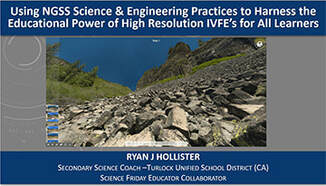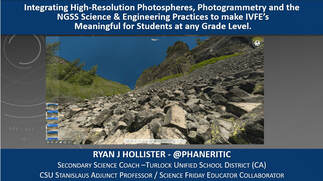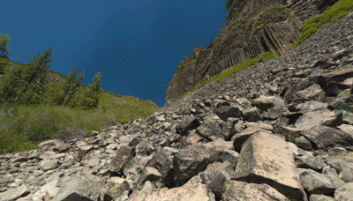My Presentation Resources
|
52-4 USING THE NGSS’S SCIENCE AND ENGINEERING PRACTICES TO HARNESS THE EDUCATIONAL POWER OF HIGH RESOLUTION IMMERSIVE VIRTUAL FIELD EXPERIENCES FOR ALL LEARNERS
HOLLISTER, Ryan J., Secondary Science Instructional Coach, Turlock Unified School District, 1600 East Canal Drive, Turlock, CA 95380Abstract |
|
Resources to Help Your IVFE Utilize NGSS Science & Engineering Practices.
NGSS Science & Engineering Practices Overview
- NGSS Science & Engineering Practices - Brief overview.
- NGSS SEP Matrix- Explains what the SEP's expect students to do.
Asking Questions
Students are allowed to explore, notice and wonder with freedom within the field site while sketching in their field notebooks.
Students use a variety of models like soap, ice and sand or 3D Models and diagrams to explore and represent their ideas and explanations.
Analyzing and Interpreting Data
Students use a customized field guide and open-ended guided questions to make sense of the landscape.
Students use their data and work collaboratively to synthesize a timeline of the geologic evidence they discovered. (Or Similar) *Teacher Facilitated*
Engaging in Argument from Evidence
Students will partake in small group and large group scientific discussions to make geologic claims at each stop using annotated guiding questions. Students must document their evidence and reasoning in Field Notebooks using the provided Geologic Evidence Guides.
Obtaining, Evaluating, and Communicating Information
Students individually use the timeline to create a story that explains the story. In this case, the formation of the Columns of the Giants.
Students are allowed to explore, notice and wonder with freedom within the field site while sketching in their field notebooks.
- Field Notebook Basics.
- Blank Field Notebook
- Packet of Materials for Students (Copy Masters Including Field Notebooks )
Students use a variety of models like soap, ice and sand or 3D Models and diagrams to explore and represent their ideas and explanations.
- My Sketchfab Rock Models
- Dexter Perkin's Rock Models
- Sample question frames to get the students thinking about the models.
Analyzing and Interpreting Data
Students use a customized field guide and open-ended guided questions to make sense of the landscape.
- Sentence Starters that ask students to make claims with evidence based on visual data.
- Full list of Question Examples from Columns of Giants IVFE
- Could include any multiple sets of data embedded within IVFE.
Students use their data and work collaboratively to synthesize a timeline of the geologic evidence they discovered. (Or Similar) *Teacher Facilitated*
- Productive Science Talk - STEM Teaching Tools # 6
- Use the Suggested Lesson Sequence to see how this is implemented.
Engaging in Argument from Evidence
Students will partake in small group and large group scientific discussions to make geologic claims at each stop using annotated guiding questions. Students must document their evidence and reasoning in Field Notebooks using the provided Geologic Evidence Guides.
- Talk Activities Flow Chart by STEM Teaching Tools.
- Geologic Evidence Guide - Scaffold student success for engaging in argument by creating field guides specific to the trip. This narrows research scope for students and gives lots of evidence from which to argue
Obtaining, Evaluating, and Communicating Information
Students individually use the timeline to create a story that explains the story. In this case, the formation of the Columns of the Giants.
- Talk Activities Flow Chart by STEM Teaching Tools.
- Science Writing Support by STEM Teaching Tools
IVFE Technical Tips (Hardware, Software, Photography)
Techniques Used to Create High Resolution Virtual Models of Geologic Specimens Using Photgrammetry
Virtual 3D geologic models created using photogrammetry are an extremely useful tool that can increase student access to hand samples and outcrops. A small community of geoscientists, teachers and students have been experimenting with photogrammetry software over the past four years to create a repository of freely-accessible geologic models on Sketchfab.com. In the absence of a geology-specific photogrammetry instruction manual, individuals used varying methods of lighting, photography and processing to generate models that were serviceable representations of the actual rock samples.
Why It Works
Thanks to continued experimentation and advances in photographic capture and processing techniques, the ability to create high resolution 3D models has dramatically improved over the past three years. Techniques, tips and tricks will include:
Virtual 3D geologic models created using photogrammetry are an extremely useful tool that can increase student access to hand samples and outcrops. A small community of geoscientists, teachers and students have been experimenting with photogrammetry software over the past four years to create a repository of freely-accessible geologic models on Sketchfab.com. In the absence of a geology-specific photogrammetry instruction manual, individuals used varying methods of lighting, photography and processing to generate models that were serviceable representations of the actual rock samples.
Why It Works
Thanks to continued experimentation and advances in photographic capture and processing techniques, the ability to create high resolution 3D models has dramatically improved over the past three years. Techniques, tips and tricks will include:
- How to create an inexpensive photo tent and turntable.
- How to create shadowless, even lighting.
- How to capture an entire specimen by using pixel targeting.
- Raw image processing.
- Improved Agisoft Metashape workflow.
|
Greenschist by phaneritic on Sketchfab |


